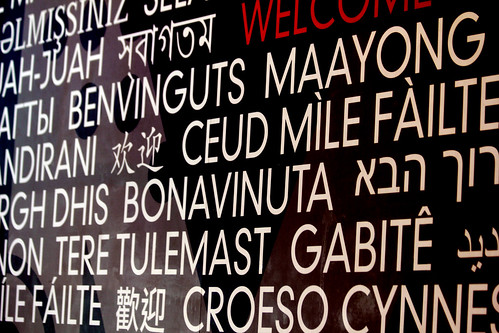Assorted thoughts and reflections on technology in education, and other things ...
Saturday, October 8, 2016
Promoting linguistic diversity
I follow people on Facebook and Twitter who speak many different languages; some I understand well, some a little and some I don't understand at all. I also post in different languages, mostly English and Swedish, and know that when I tweet in Swedish I only reach a few of my potential audience, the others will just not read it. However once you get used to clicking on the translate button suddenly new communication channels open up for you. The translations are not perfect but a lot better than not understanding at all. Unfortunately I fear very few people take the trouble to do this. Most people in the world live in a multilingual environment where a working knowledge of several languages is not unusual. However on the net that diversity is often missing, even if there are rapidly improving tools that could enable multiligualism. In general all international discussions are in English and those who are not fluent are relegated to the sidelines and passive observers.
Linguistic diversity has of course always existed. It's only in the last 150 years that we, especially in Europe and North America, have adopted the arrogant notion of each country having only one language and as a result any diversity has been viewed as uncomfortable, sometimes even undermining the notion of the monocultural nation state. English is now the undisputed language of international communication but even accepting this I still think that those who are not fluent deserve the right to be heard and it's time to learn again to live with diversity. In the case of a rapid-fire chat on Twitter you don't have time to sit and think about how to formulate yourself correctly and if you can do that faster in your own language, why not? Automatic text translation is improving every year and with that comes the opportunity for silent participants to become active participants.
A colleague alerted me recently to the concept of translanguaging that is being increasingly used in multilingual classrooms around the world. Here bilingual students are encouraged to use their full linguistic range by, for example, doing group work in one language and reporting back in another. Students are encouraged to translate for each other and as a result multilingualism becomes embedded in everyday practice. You accept that you can't understand everything in every language but the group soon works out strategies to minimise misunderstanding and many acquire new language skills simply through exposure and help from friends. This might be seen as a challenge to the teacher's authority but it can help shift the teacher's role towards that of facilitator and mentor. Even if the teacher is monolingual it is possible to learn basic expressions in all the class's languages and empowering the students as interpreters. The result is that everyone can express themselves and noone is excluded on language grounds. If this can be achieved in the classroom where the spoken word is so vital then surely it's possible in an online environment with all the tools and apps we have at our disposal.
Translanguaging pedagogy requires a different type of teacher, a co-learner. Classrooms are increasingly multilingual in the world. It is impossible for teachers to know all the languages of students. But it is possible for teachers to build a classroom ecology where there are books and signage in multiple languages; where collaborative groupings are constructed according to home language so that students can deeply discuss a text in the dominant school language with all their language resources; where students are allowed to write and speak with whatever resources they have and not wait until they have the “legitimate” ones to develop a voice; where all students language practices are included so as to work against the linguistic hierarchies that exist in schools; where families with different language practices are included. Any teacher, including a monolingual one, can take up translanguaging to enable their bilingual students to make deeper meaning and legitimize their home language practices.
What is Translanguaging? An interview with Ofelia García (Psychology Today, March 2016)
Of course there will always be a lingua franca in every class, group or community and it is essential that everyone has at least a working knowledge of it to be part of that group. However we can still facilitate a more multilingual environment to be as inclusive as possible. The main difficulty is winning over monolinguals to seeing it not as a threat but as an enabler. If we can get used to seeing comments in an online discussion in a variety of languages and can cope with the momentary inconvenience of clicking the translate button we may finally hear what previously silent colleagues think and the discussion can only benefit from new perspectives.
Subscribe to:
Post Comments (Atom)

We have run #LTHEchat in two languages a couple of times (French and German). The questions were posted twice in each language. From my own perspective I found it fun using Google translate to both help me understand what was being posted but also to attempt to answer. I have only a basic and rusty memory of school French. It did help the recall and makes me wonder if I engage in this more often would I be able to unlock prior learning.
ReplyDeleteGood example Sue. It's all about greater inclusion. We native English speakers often forget that everyone else is forced to used their 2nd, 3rd, 4th language when participating in discussions. We need to get used to struggling a little!
ReplyDelete